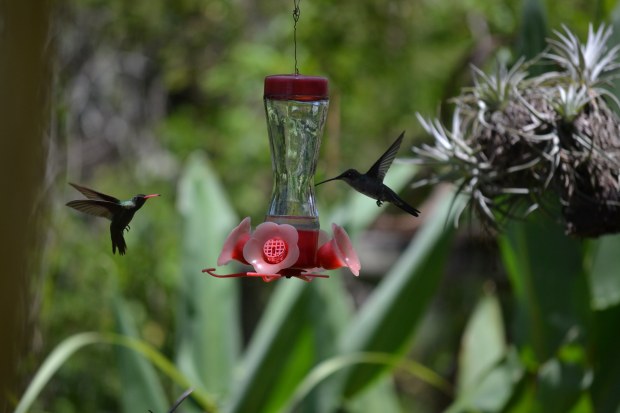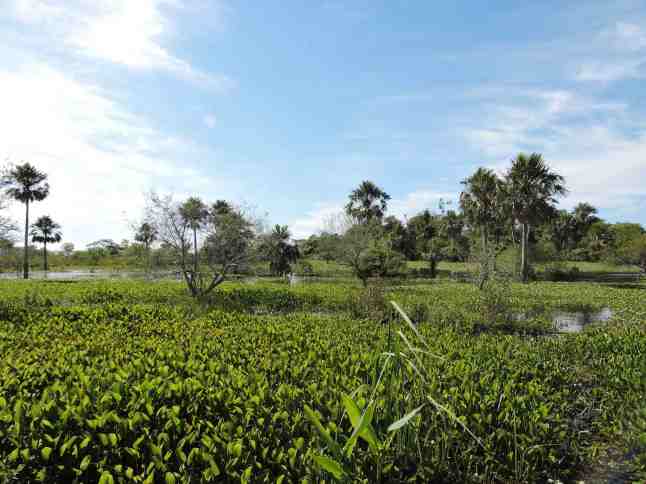We visited the Esteros de Iberá (Yverá in its original Guaraní denomination)[1] a few years back and the idea of returning stayed with us. Taking advantage of the visit of our children during the 2015 season’s holidays we booked a three-night stay at Rincón del Socorro. I quote from their web site (http://rincondelsocorro.com/):
“Rincón del Socorro has 12.000 hectares and is located in the Iberá Wetlands. It has been historically managed as a cattle ranch until 1999 when it was bought by The Conservation Land Trust (CLT), who now dedicates to care for its environment through a group of biologists and veterinarians who develop different restoration and reintroduction programs of species. As a touristic establishment, we provide to our guests a close understanding to the local ecosystem, appreciating the importance each different natural environments and conservation it has“.
The CLT was created in 1992 by Douglas Tompkins to protect wild lands, primarily in Chile and Argentina. It was blatantly obvious that a large investment has taken place not only in the refurbishment of the ranch but also in the general area of the wetlands. The hostel at Rincón del Socorro is managed by a private concession that employs about 40 people, including the guides. We were very fortunate to get “Mingo” as ours as he proved to be a great companion who patiently explained most of the questions we asked and who had no problems in admitting not knowing an answer on the few occasions that he did not.
To reach the place required a long journey of about 750 km from Carmelo, our hometown in Uruguay. Bookings were made about one month before the visit and being this a wet summer I immediately got “cold feet” about the very likely possibility of a rains during our visit planned for 2-5 January. However, there was not much I could do but hope that the usual luck that accompanies us would be with us again.
My concerns were not lessened the day before as 2015 started with heavy rain! A rather desperate last minute check to the weather forecast showed “suns” so hope was somehow maintained. The lucky strike started when getting up very early on the 2nd of January where clear skies greeted us. This magnificent weather stayed with us and we had four beautifully -and even relatively cool- sunny days that enabled us to enjoy the trip to the full and the playing cards and dice we brought with us in case of rain were not remembered. Amazingly, it started raining after we got back to Carmelo and it continued to pour until the 8 January!
During our stay we joined all available activities: animal watching walks and drives, boat trips to lake Iberá as well as a -rather painful to me- horseback ride. All these activities combined allowed us -with the advice of Mingo- to understand the different ecological areas that are found in the wetlands that I will try to briefly describe to you.
The Iberá Provincial Reserve is a protected area in the northwest of Corrientes Province, northeastern Argentina. The entire area is in the shape of a funnel, with the conical mouth towards the northeast and the stem pointing towards the southwest, ending in the Corriente River. Established on 15 April 1983, with an area of about 13,000 km2 it contains a mix of habitats that I will briefly describe to put the place in context. More information is available in the web, of course.
The lagoons, up to a depth of five metres, and the floating islands are an important feature. The latter are composed of floating organic material where giant bulrush (Schoenoplectus californicus) (Totora in Spanish) predominates among others such as yellow laurel (Nectandra angustifolia). These islands determine the shape of the open water while the water circulates underneath towards the Corriente River (the funnel’s stem). The latter with its sandy banks maintains a constant and slow flow that will eventually flow into the mighty Paraná River. Its very wet and sandy banks do not allow for the growth of large vegetation.
There are large areas of swamps and reeds, particularly towards the northeast where the water has filled depressions and accumulated over time, creating large flooded grasslands and reed beds mainly formed by piripiri (Cyperus giganteus) a kind of papyrus and giant bulrush that rarely dry out. In other areas grass fields made up predominantly of red grass (Andropogon lateralis) predominate and walking on it reveals small depressions filled with water. These micro lagoons enable the development of truly small aquatic systems. Finally, there is another grassland system in the sand hills of North and West Iberá where scattered patches of forest and/or little round blue lagoons interrupt the grasslands known locally as “espartillares”.
Palms occur in the form of groves of the small Dwarf Yatay Palm (Butia paraguayensis) that grow in the higher parts of the area as well as Caranday Wax Palm (Copernicia alba) that grow in sand and clay. As these palms are water tolerant they can survive floods and form dense forests that occupy areas where most land and aquatic plants do not survive.
There are patches of wet forest that have a limited lifespan as conditions are not ideal for the growth of the common forest trees such as queen palm (Syagrus romanzoffiana), the gum tree (Sebastiania brasiliensis), the ombú tree (Phytolacca dioica), the pacara earpod tree (Enterolobium contortisiliquum), and the lapacho tree (Tabebuia spp.). Drier areas are populated by Ñandubay trees (Prosopis affinis), with their medium height and flattish canopies creating dry forests in the savannah.
The place is also an animal paradise with many interesting and rather unique species. Abundant southern screamers (Chauna torquata) were spotted while living up to their names and screaming in alarm at our approach while the rheas (Rhea americana) grazed undisturbed.
The estimated number of bird species identified in the wetlands is nearly 400 and therefore there are too many to mention. However, the pair of Jabiru storks (Jabiru mycteria) nesting near the ranch were simply spectacular.
 On the other end of the size spectrum (tiny), but not less impressive were the various humming birds as well as the aptly named Strange-tailed Tyrant (Alectrurus risora), spotted too far to capture it on film but that can be seen in: http://www.pbase.com/james_lowen/image/88253519.
On the other end of the size spectrum (tiny), but not less impressive were the various humming birds as well as the aptly named Strange-tailed Tyrant (Alectrurus risora), spotted too far to capture it on film but that can be seen in: http://www.pbase.com/james_lowen/image/88253519.

A Glittering-bellied Emerald Hummingbird (left) and probably a female Blue-Tufted Starthroat Hummingbird at a feeder in Colonia Carlos Pellegrini.

Blue-Tufted Starthroat Hummingbirds (perched, left and in flight top right) and a Glittering-Bellied Emerald Hummingbird (flying, right). All Hummingbird pictures by Mariana Terra..
The mammals spotted were mostly rodents. Capybaras (Hydrochoerus hydrochaeris) being very abundant both in the swamps as well as in the small lakes we visited. It was interesting to notice that while the latter were rather brown in colour, the ones inhabiting the swamps and grasslands had a reddish tinge as if henna would have been applied to them.
Plains Vizcacha (Lagostomus maximus) were also present in numbers, mainly grazing around their burrows and it was very entertaining to see them carrying various objects to their burrows. They are the largest of the Genus and they build elaborate burrows that house successive colonies for generations.
Grey (Lycalopex gymnocercus) and Crab Eating foxes (Cerdocyon thous) were seen daily and three Hog-nosed Skunks (Conepatus chinga), a mother and two babies, were seen daily at the ranch’s park, stamping their forelegs in warning when we got too close, failing to get good pictures as they appeared only at dusk. We also saw a family of Black Howler Monkeys (Alouatta caraya) but did not see the rare Maned Wolf (Chrysocyon brachyurus) or the re-introduced Giant Anteater (Mymecophaga tridactyla). However, our disappointment was somehow lessened by enjoying the sight of a Screaming Hairy Armadillo (Chaetophractus vellerosus) standing in its burrow and three Nine-banded Armadillo (Dasypus novemcinctus) walking in the meadows.
We were accommodated at the refurbished ranch facilities. The rooms were very comfortable and they were up to the high standards we have enjoyed. All activities and meals were included in the price. The latter were good and the service did not make us wait. We were all very satisfied except for our son who in his early twenties, who during dinner on the first day got small portions of food and only his British education kept him from making the remarks I would have made being in his place! He also stoically tolerated our jokes. He was pleased at breakfast as it was a buffet and he could serve himself the portion size he wanted!
The respite given by the good breakfast ended at lunch where he received the smallest portions again! After that, anticipation regarding his portion size for dinner grew as the day went on and, yes, we were not disappointed as he again got the smaller portion. This made us all laugh loud to the surprise of the other guests and waitresses who did not understand the reason for such a mirth! As the situation repeated itself at all meals, it soon became an expected event and we did not laugh anymore but felt sorry for our son and even contributed from our portions to enlarge his! Well, his mother did anyway…
Finally, during our last dinner it was the time for us to get the surprise as he was somehow rewarded when he was presented with the largest -by far- cheesecake portion of all. He did not leave one crumb as he ate it with a smile in his face!
[1] Iberá means Brilliant Waters.













